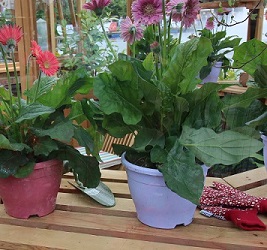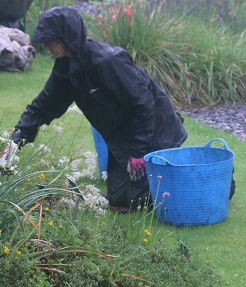Sneak Peek
This is a self Paced 20-hour course to help you understand and Learn Essential Gardening Skills
Gardening can be a lot of fun, a hobby or a job. Without an understanding of the basics though, mistakes are easily made. Time and money can be wasted doing gardening tasks incorrectly, or with the wrong equipment and materials. This short course can be studied in your own time and is great way of learning all of the gardening essentials.
This course is a great way of minimising those issues, and creating a better looking, more functional garden.
If you are a home gardener -be a better one.
If you work in the garden industry - stop making basic mistakes that are easily avoided.
A little gardening knowledge can go a long way.
Our 20 hour courses are self paced and will help you understand a topic in a short amount of time.
Course Content - What do you learn?
Lesson 1 APPROACHES TO GARDENING
Ways to Garden
Garden Planning
Review what you have been learning
Lesson 2 TOOLS AND EQUIPMENT
Selecting and Using Tools and Machines
Types of Gardening Tools and Equipment
Equipment
Review what you have been learning
Lesson 3 PLANTS AND PLANTING
Plant Names
Plant Groups
Planting in Garden Beds
Taking Care of Young Plants
Greenhouses and Shade houses
Review what you have been learning
Lesson 4 GROWING MEDIA AND POTS
Soil Composition
Problems with Organic Materials
Potting Media
Plant Containers
Review what you have been learning
Lesson 5 WATERING AND FEEDING
Applying Water to Plants
Trickle Irrigation in Easy Care Gardens
Water Saving Measure
Feeding Plants
Review what you have been learning
Lesson 6 PESTS, DISEASES AND WEEDS
Biological Competitors
Environmental Problems
The Importance of Healthy Soil to Plant Health
Garden Hygiene – Keeping the Garden Healthy
How Water Affects Plant Health
Air, Soil Temperature, Light: Importance to Plant Growth
Biodiversity: The Path to Garden and Plant Health
Plant Protection
Protecting from Cold and Heat
Using Organic Sprays and Dusts
What Makes a Weed?
Using Weedkillers
Weed Identification
Weed Control Methods
Review what you have been learning

Lesson 7 PRUNING AND MOWING
Pruning Plants
Grass Surfaces
Maintaining Lawns
Review what you have been learning
Lesson 8 GARDENING TECHNIQUES
Organic Gardening
Permaculture
No-dig Gardening
No-Till Planting in Turf
Making Compost
Crop Rotation
Seed Saving
Environmental Horticulture
Integrated Pest Management
Hydroponics
Bonsai
Review what you have been learning
Final Assessment
Learn Your Plants and How to Plant them
Every type of plant is unique; sometimes a little different to other plants, and sometimes very different. They differ not only in how they look, but also in how you need to treat them.
All gardeners need a reasonable knowledge of plants. This means knowing plant names, identifying plants, understanding different groups of plants, and how to plant them.
PLANT NAMES
Plants are given two kinds of names: common and scientific.
Common Names
Common names are English language names usually given to plants by amateur gardeners as a descriptive, easy-to-remember tag. Many plants have more than one common name and sometimes the same common name is given to several quite different plants. This and the fact that there is no real control over common names make them inaccurate and unreliable for plant identification.
Scientific Names
Based on Latin language, these names seem more complex than common names; however they have a logic to them that actually makes plant identification easier. The system of scientific naming is strictly controlled and coordinated by botanists throughout the world. Scientific names (e.g. Camellia japonica) should always be used in preference to common names.
Planting in Garden Beds
Plants bought from nurseries and garden centres are mostly in pots, trays or tubes. Larger specimens may be in bags. When transplanting from pots into garden beds, this may be done as follows:
- Thoroughly soak the plant in the pot. This helps the plant come out of the pot more easily. Allow it to drain.
- Use a spade to dig an irregular-shaped hole in the garden bed to at least twice the width of the pot, and one and a half times the depth of the pot. Loosen the sides of the hole with the edge of the spade, especially for heavy clay soils.
- Fill the hole with water to check for drainage.
- Adjust drainage if required by loosening the subsoil using a fork. Alternatively, plant into a raised mound or bed.
- Fill in one-third of the hole using the same soil dug from the hole.
- Take the plant out of its pot. Hold the stem of the plant firmly, lift it and gently tap the rim of the pot to loosen it.
- If the roots are massed at the edges of the root ball gently tease them out. If they are thick and circling the base of the plant, use a sharp knife or secateurs to remove a centimetre or two.
- Place the plant in the hole, making sure it at the same depth in the soil as it was in the pot. Back fill the hole with soil then firm the soil down gently using your hands.
- Make a lip of soil around the base of the plant to hold water.
- Soak thoroughly with water.
- Sprinkle some organic fertiliser over the surface and place a layer of organic mulch around the plant ensuring it is not in direct contact with the plant stem.
Many deciduous plants such as roses are sold as bare-rooted plants in winter when they are dormant. The roots of bare-rooted plants must be kept continually moist prior to planting. They can be soaked in a bucket of water overnight before planting. Any swellings are best cut off as these may be due to disease. If you cut the roots back for this, or any other reason, cut the top back proportionally. Ideally, any cuts should be dusted with a fungicide.
How does this course work?
You can enrol at any time.
Once you have paid for the course, you will be able to start straight away.
Study when and where you like. Work through at your own pace.
You can download your study-guide to your smart phone, tablet or laptop to read offline.
There are automated self-assessment tests you can complete at the end of each lesson. You can attempt these as many times as you wish and each time, upon completion, you can see your results. You will need internet access to complete the self assessment tests.
At the end of the course, you are presented with a large assessment which can be attempted online, anywhere, anytime. If you achieve a 60% pass in the exam; you immediately receive a downloadable certificate of completion with your name on it. If you do not achieve a 60% pass rate, you can contact us to re-sit your exam. ( email- admin@acs.edu.au )
Contact us at anytime if you have any issues with the course. admin@acs.edu.au